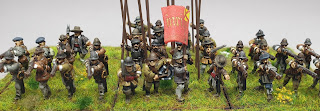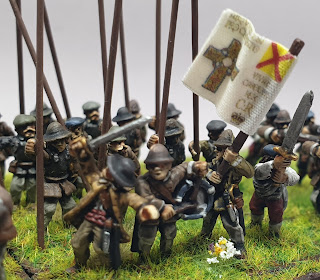Colonel Manus O’ Cahan’s Regiment of Foot

Here's the third of three Irish regiments of foot; Colonel Manus O’Cahan’s Regiment of Foot. Not much is known about O'Cahan (prononunced O'Kane) or his men. An experienced soldier, both he and his Regiment had been recruited from Owen Roe O'Neil's Northern Army of the Irish Confederation in the early months of 1644. Captain Mortimer’s company of dragoons grew out of the Regiment: musketeers started being provided with horses for scouting and raiding parties, eventually becoming classed as dragoons in March 1645. O'Cahan's was made up of seven companies which were formed along a sectarian divide: five companies of Protestants, and two made up of Catholics. This sectarian divide would provide grounds for confusion and inter-regimental fighting (and I don't mean not so friendly fisticuffs). Shipped to Scotland in the first half of 1644 they fought at Kinlochaline Castle; Tippermuir, where they fielded 400 men; Aberdeen; Fyvie; raided Inverary; Inverlochy,...


